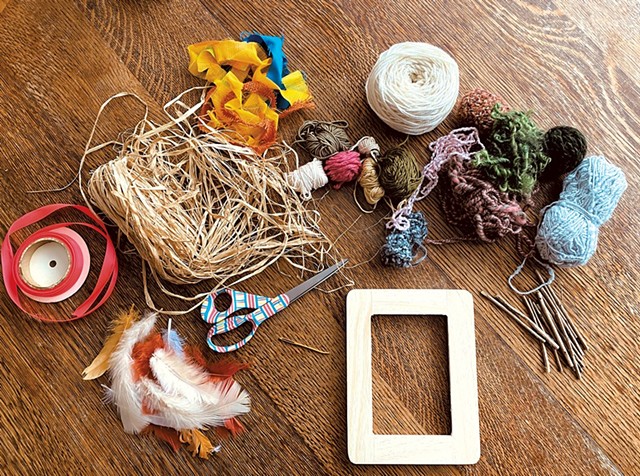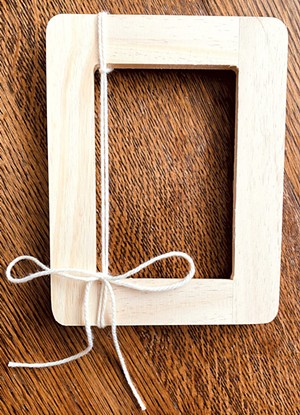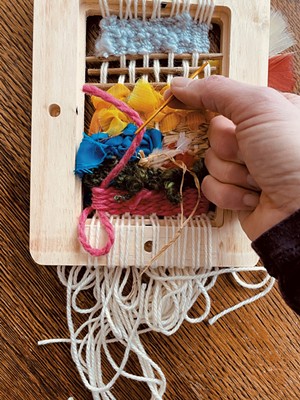
- Bradie Hansen
- Weaving materials
While March in Vermont means fluctuating weather, there's something your family can do to bring consistency, calm and creativity to this fickle month. Try weaving, a process that involves interlacing yarn, fiber, and even leaves and sticks to create a decorative textile. Thousands of years ago, our ancestors wove clothing, baskets, blankets and sails. The basic technique remains the same.
Together, your family can use weaving skills to create wall-worthy art on a budget. Weaving is accessible for most and can help build hand-eye coordination, strengthen fine motor skills and boost mood.
Bradie Hansen, a Burlington-based therapist and fiber artist/handcrafter, says that mindfulness and weaving are intrinsically connected. Hansen grew up surrounded by female artists and handcrafters, and her work evolved from knitting to crocheting to spinning wool and, now, weaving. When her son, Jacob, was younger, she noticed that when he was engaged in fiber arts, the rhythm of his breathing "became deep and slow, similar to yoga breathing." She volunteers at her children's classrooms at Shelburne Community School, teaching students to weave, knit, prepare wool and spin yarn. She has come to understand the importance of "giving kids space to experiment with all sorts of materials and textures." When possible, she creates projects that can be completed in one sitting so that children can see very quickly that they can learn new skills and make beautiful art.
Framed Weaving Project

- Bradie Hansen
- Step 3: Tie warps
Use basic weaving technique and various materials to capture a walk on the beach, a hike through the woods, a family vacation or even your child's early years (if you use strips of cloth from a favorite baby outfit). The finished work of art will be a tangible memory of shared family moments.
Materials: Scissors, a tapestry needle, a picture frame without the back, sturdy yarn for warp threads, (the longitudinal yarns that are held stationary in tension) and an assortment of materials to weave with including yarn, fabric scraps, grasses, feathers, seagrass, etc.
Step 1
Cut Warps: Cut a length of yarn that, when folded in half, still is at least six inches longer than the frame.
Step 2
Loop Warps: Lay the folded warp yarn on top of the frame, pulling the looped end over the back. Bring the two loose ends through the loop and pull until snug.
Step 3
Tie Warps: At the bottom of the frame, take those two loose ends over the front of the frame and up the back, bringing them up and over themselves, and tie in a bow.
Step 4
Continue Warps: Repeat steps 2 and 3 to create a loom. A quarter of an inch between warp threads is a good place to start, but feel free to experiment with distance.
Step 5
Tie and Weave: Begin with yarn, using about an arm-and-a-half length. Tie one end to the side of the frame. Thread the other end through your tapestry needle and begin weaving. Treat each set of two warp threads as one thread. Go over the first one, under the next, over the third one, under the next, and so on.
Step 6
Second Row: When you get to the end of the first row, come back the other way. If you went over the last warp thread of the last row, you'll come under that same warp thread as you head back. Younger kids sometimes have a tough time with this part!
Step 7
Play With Materials: Shake things up by including new colors and materials. You can start a new material at any point in your weaving.
Step 8
Fabric: Use scraps of fabric to add visual interest.
Step 9
Sticks and Treasures: Use the same weaving technique with cool sticks or other treasures from nature, like dried flowers, straw and grasses.
Step 10
Finalize: If you are using found feathers, make sure to clean them first. (Instructions can be found online.) End your weaving with yarn, working as high as you can in order to stabilize the tapestry and prevent it from coming loose.
Step 11
Loose Ends: Turn your piece over gently and weave in the loose ends of yarn. As pictured with the pink yarn in the photo to the left, go up several rows of weaving and down the next. Snip off loose ends.
Step 12
Secure and Display: Secure bows by either double knotting them at the bottom or by tying the loop from one bow to the loop of the neighboring bow. Cut the loops to make fringe. Get creative and cut the fringe into different shapes, secure seashells to the ends or totally unravel the ends to make it wild!
Weaving books
Reference books:

- Bradie Hansen
- Step 11: Secure loose ends
Kids Weaving: Projects for Kids of All Ages, by Sarah Swett
Nature's Art Box: From T-Shirts to Twig Baskets, 65 Cool Projects for Crafty Kids to Make With Natural Materials You Can Find Anywhere, by Laura C. Martin
Weaving With Children, by Ute Fischer
Picture books:
Weaving the Rainbow, by George Ella Lyon, illustrated by Stephanie Anderson
Abuela's Weave, by Omar S. Castañeda, illustrated by Enrique O. Sanchez
The Weaving of a Dream, by Marilee Heyer
Leave Me Alone!, by Vera Brosgol
Extra Yarn, by Mac Barnett, illustrated by Jon Klassen
Ox-Cart Man, by Donald Hall, illustrated by Barbara Cooney
Websites
Shop Locally for Weaving Materials At:

- Bradie Hansen
- Step 12: Secure and display weaving
- Mad River Fiber Arts & Mill, 6163 Main Street, Waitsfield (classes available)
- Mountain Fiber Folk, 188 Main Street, Montgomery Center (classes available)
- Must Love Yarn, 2438 Shelburne Road, Suite 2, Shelburne
- Northeast Fiber Arts Center, 7531 Williston Road, Williston
Find weaving classes at:
- Marshfield School of Weaving, 589 Eaton Cemetery Road, Marshfield
- Shelburne Craft School, 64 Harbor Road, Shelburne
- Vermont Weaving School, 4 Signal Pine Road, Putney










Comments
Comments are closed.
From 2014-2020, Seven Days allowed readers to comment on all stories posted on our website. While we've appreciated the suggestions and insights, right now Seven Days is prioritizing our core mission — producing high-quality, responsible local journalism — over moderating online debates between readers.
To criticize, correct or praise our reporting, please send us a letter to the editor or send us a tip. We’ll check it out and report the results.
Online comments may return when we have better tech tools for managing them. Thanks for reading.